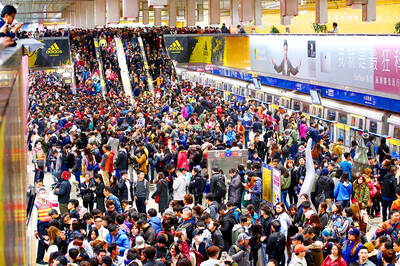The Centers for Disease Control (CDC) yesterday urged medical practitioners to be vigilant after a new dengue fever case was diagnosed only on a third visit to a doctor.
A man in his 60s who lives in Jhongsiao Borough (忠孝) in Tainan’s East District (東區) was diagnosed with the disease after symptoms appeared on Saturday last week. He has not traveled overseas recently.
The man sought treatment on Sunday last week and Thursday for fever, headache, loss of appetite and fatigue, but dengue fever was not diagnosed, the CDC said.

Photo courtesy of the Centers for Disease Control
City health authorities tracking those who had direct contact with people diagnosed with the disease spoke with the man on Friday and test results showed the he was infected with dengue virus type 2.
During the incubation period, the man visited Barclay Memorial Park and Fucheng Kai-Di Temple (府城開帝殿) in East District, the centers said.
His workplace in Chongde Borough (崇德) is close to the homes of people previously confirmed to have the disease, so he might have contracted the disease there, it said.
Fifty-four indigenous dengue cases have been confirmed so far this year, 42 in Kaohsiung and 12 in Tainan, the centers said, adding that 225 cases were brought in from other countries, the most for the period in the past decade.
CDC Deputy Director-General Chuang Jen-hsiang (莊人祥) said that as initial symptoms of dengue are similar to those of many common diseases, doctors should be extra vigilant and ask people they treat about recent travel or if they live in or near areas where dengue cases have been reported.
A low-pressure system that brought heavy rain to many areas in southern Taiwan in the past week caused flooding and puddles, so people should remove standing water to prevent mosquitoes from breeding, the centers said.

People can take the Taipei MRT free of charge if they access it at Nanjing Sanmin Station or Taipei Arena Station on the Green Line between 12am and 6am on Jan. 1, the Taipei Department of Transportation said on Friday, outlining its plans to ease crowding during New Year’s events in the capital. More than 200,000 people are expected to attend New Year’s Eve events in Taipei, with singer A-mei (張惠妹) performing at the Taipei Dome and the city government’s New Year’s Eve party at Taipei City Hall Plaza, the department said. As people have tended to use the MRT’s Blue or

Civil society groups yesterday protested outside the Legislative Yuan, decrying Chinese Nationalist Party (KMT) efforts to pass three major bills that they said would seriously harm Taiwan’s democracy, and called to oust KMT caucus whip Fu Kun-chi (傅?萁). It was the second night of the three-day “Bluebird wintertime action” protests in Taipei, with organizers announcing that 8,000 people attended. Organized by Taiwan Citizen Front, the Economic Democracy Union (EDU) and a coalition of civil groups, about 6,000 people began a demonstration in front of KMT party headquarters in Taipei on Wednesday, organizers said. For the third day, the organizers asked people to assemble

Taipei is participating in Osaka’s Festival of Lights this year, with a 3m-tall bubble tea light installation symbolizing Taiwan’s bubble tea culture. The installation is designed as a bubble tea cup and features illustrations of Taipei’s iconic landmarks, such as Taipei 101, the Red House and North Gate, as well as soup dumplings and the matchmaking deity the Old Man Under the Moon (月下老人), affectionately known as Yue Lao (月老). Taipei and Osaka have collaborated closely on tourism and culture since Taipei first participated in the festival in 2018, the Taipei City Department of Information and Tourism said. In February, Osaka represented

Taiwanese professional baseball should update sports stadiums and boost engagement to enhance fans’ experience, Chinese Professional Baseball League (CPBL) commissioner Tsai Chi-chang (蔡其昌) told the Liberty Times (sister paper of the Taipei Times) in an interview on Friday. The league has urged Farglory Group and the Taipei City Government to improve the Taipei Dome’s outdated equipment, including relatively rudimentary television and sound systems, and poor technology, he said. The Tokyo Dome has markedly better television and sound systems, despite being 30 years old, because its managers continually upgraded its equipment, Tsai said. In contrast, the Taipei Dome lacked even a room for referees